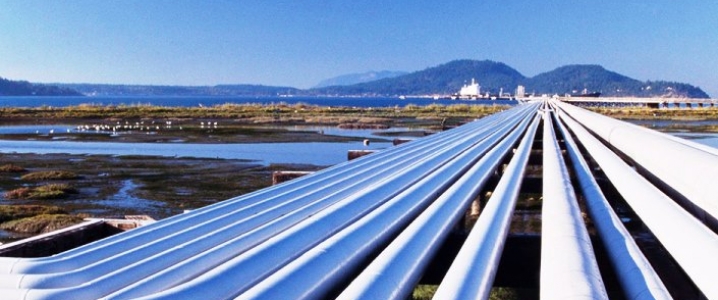Natural Gas Prices Poised To Rise As Exports Boom

New data from the Energy Information Administration (EIA) has brought some good newsfor advocates of U.S. natural gas production. In three of the first five months of 2017, the United States exported more natural gas than it imported, reversing a trend of net-imports that’s endured for nearly sixty years.
Rising exports, fueled by a the shale boom which has seen a marked increase in U.S. natural gas production, have been facilitated by new infrastructure and rising demand outside the U.S., most notably in Mexico and eastern Canada.
The United States began importing large amounts of Canadian natural gas in 1958, when the TransCanada natural gas pipeline was completed. Significant quantities of Canadian natural gas continue to flow over the border, chiefly through pipelines in Idaho and Montana.
But now, rising natural gas output from the shale boom has displaced Canadian production, reducing the volume of Canadian imports. There has been a simultaneous increase in demand for U.S. natural gas in eastern Canada, which is better supplied from U.S. sources than from distant Alberta, the hub of Canada’s energy industry. While the U.S. remains a net importer of Canadian energy, the urban centers of Toronto, Quebec and Montreal are becoming increasingly reliant on U.S. natural gas piped in from the south.
In March 2017, U.S. natural gas exports to Canada reached 3.21 billion cubic feet/day, nearly breaking a record of 3.25 bcf/d set in 2012. Imports of Canadian natural gas, which reached a peak of 12 bcf/day in 2007, were around 8 bcf/day.
The real story in U.S. natural gas exports, however, is in Mexico. Natural gas exports south of the border reached near-record levels in the first half of 2017, averaging 4.04 bcf/d.
Exports to Mexico have been steadily increasing since 2010, a sign of growing U.S. production and declining Mexican output, but also an indicator of the growing demand in Mexico for natural gas for electricity production and industrial activities. Natural gas accounts for sixty percent of Mexican electricity demand, though upstream activities have been increasing since the 2013 Energy Reforms and the country’s domestic production could swing back in the years to come.
The pipeline network linking the U.S. to Mexico has been improved and updated in the last five years, with new pipelines increasing the total export volume to 7.3 bcf/d. Plans for additional pipelines featured heavily in U.S. President Donald Trump’s speech on energy policy in late June 2017, despite his repeated calls that a wall be built between the two nations. The President suggested the new pipeline could be built “under the wall,” eliciting a few chuckles from his audience.
Jokes aside, the U.S. is likely to remain a major source of energy for Mexican consumption in the years ahead. New pipelines, including the Roadrunner (Phase II), Comanche Trail and Presidio Crossing projects will increase U.S. capacity to deliver natural gas to Mexico, directly linking the nation’s most productive shale areas to high-growth markets. Total U.S. natural gas export capacity to Mexico is set to increase to 15 bcf/d.
The other aspect of U.S. natural gas export growth has been the increase in liquefied natural gas shipments (LNG) from the nation’s single operational LNG terminal at Sabine Pass in Louisiana. Since coming on line in February 2016, Sabine Pass has commissioned three liquefaction trains, allowing exports to reach 2 bcf/d in 2017.
Some of this product has been delivered to Mexico, largely to feed demand in the country’s central regions which have experienced natural gas shortages. Shipments to Mexico reached 14 bcf in January 2017.
Harold Hamm, a pioneer of the U.S. shale boom, is anticipating a surge of U.S. LNG exports. The energy lobbyist has the ear of President Trump, who has been vigorously promoting increased U.S. energy production. Yet Hamm has acknowledged that the real barrier to LNG exports is not capacity, but demand. Right now, the U.S. competes with other LNG exporters for markets in East Asia and South America.
Mexico, which has been taking LNG shipments to correct for natural gas shortages in its central regions, may be weaning itself off LNG as more natural gas becomes available via pipeline. The boom in pipeline construction linking U.S. shale to markets in Mexico may price LNG out of the market: liquefying and transporting the gas via tanker is more expensive than simply pumping it through a pipeline.
The EIA believes LNG will drive increasing U.S. energy exports, amounting to more than half of all energy exports by 2040. With natural gas now flowing out of the U.S. to markets north and south, and with new capacity being added yearly, it seems likely that the boom in natural gas will endure despite lower-than-average prices. All that is required is for demand to match the abundant supply.
Related News
Related News

- Keystone Oil Pipeline Resumes Operations After Temporary Shutdown
- U.S. House Passes Bill to Reverse Biden's LNG Pause
- Biden Administration Buys Oil for Emergency Reserve Above Target Price
- Enbridge to Invest $500 Million in Pipeline Assets, Including Expansion of 850-Mile Gray Oak Pipeline
- Williams Delays Louisiana Pipeline Project Amid Dispute with Competitor Energy Transfer
- Evacuation Technologies to Reduce Methane Releases During Pigging
- U.S. Regulators Approve Mexico Pacific LNG's Saguaro Connector Pipeline
- Editor’s Notebook: Nord Stream’s $20 Billion Question
- Enbridge Receives Approval to Begin Service on Louisiana Venice Gas Pipeline Project
- Russian LNG Unfazed By U.S. Sanctions




Comments